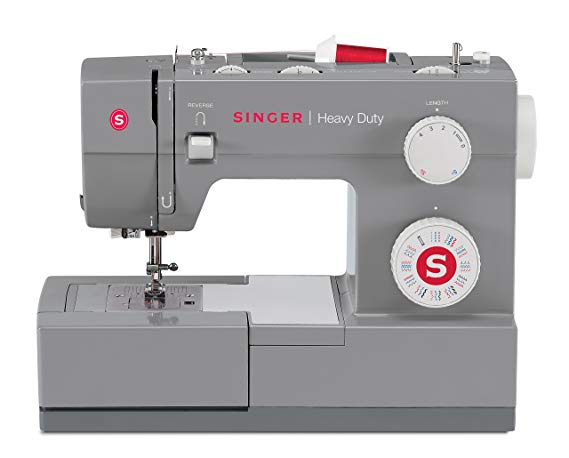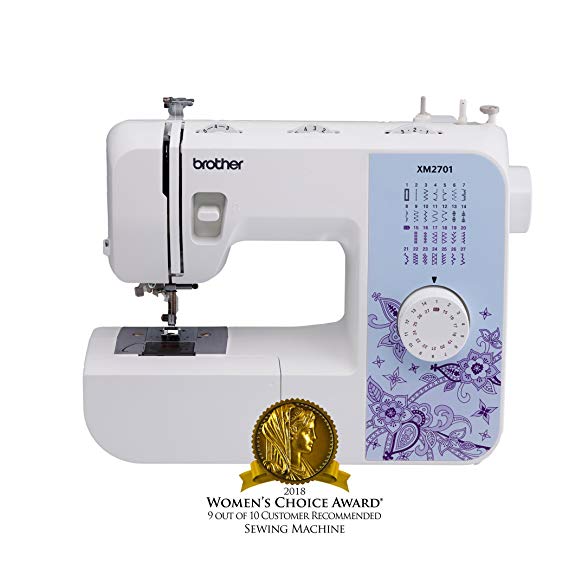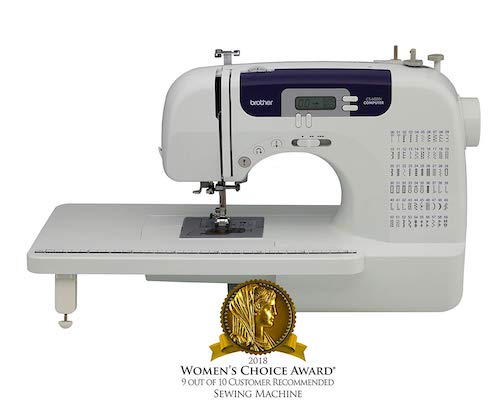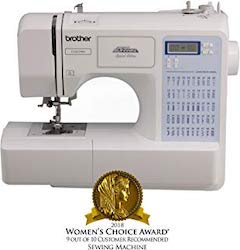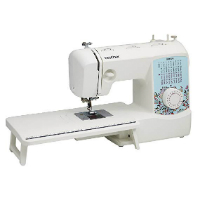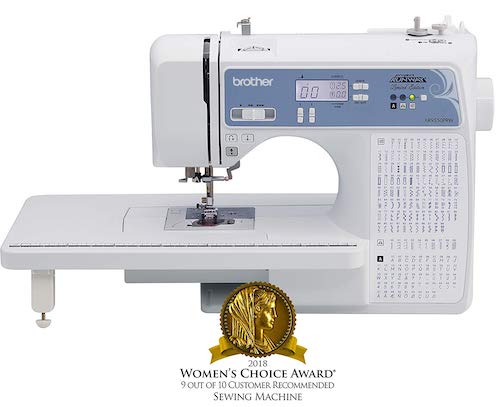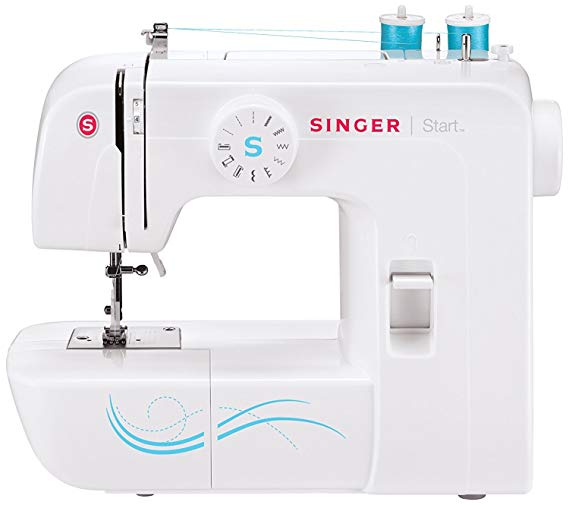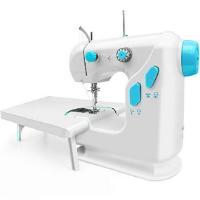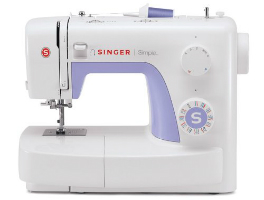Best Sewing Machine For Beginners
Please Note: This Post Contains Affiliate Links
Expand Table of Contents
It’s never too late to take up sewing. You don’t need to sew clothing either: sewing is an important skill for everyone to have in daily life.
Fix holes in your clothing, sew a blanket that’s been worn down, or add on to your current clothes and bags to make them more useful. Sewing is an important skill, but what ifme you don’t have any experience sewing?
For those of you who are just starting out, you might feel intimidated by all the sewing machines on the market. It’s hard to know which one will work best for you, and which one won’t be too confusing for you to use.
Instead of picking out the fanciest and complicated sewing machine, we're here to take a look at the best sewing machine for beginners so you can get started off right.
Choose one of these more basic sewing machines specifically for beginners, all of which should be easy to use without being so simple that you can’t get anything done. When just starting out and doing basic stitches, you need a sewing machine that makes things easier.
Sewing Machine | Summary |
|---|---|
You have a heavy-duty sewing machine at the tip of your fingers with the Singer 4423, with features like automatic thread to make your start to sewing easy. | |
Talk about perfect for beginners. The Brother XM is not only powerful but includes a jam-resistant top bobbin and LED work area so every project goes easily | |
This sewing machine is completely user-friendly, with an adjustable sewing speed control option so that everyone is able to use it comfortably | |
Get high-quality stitches with this easy-to-use Brother Project Runway model. Stitch like an expert while still learning along the way. | |
You have the features of an expert for the price of a beginner with the Brother XR3774. Add buttons to your clothing and use the automatic threader for a price that’s more than worth it. | |
Brother XR9550PRW | The Brother XR9550 has everything you need to sew like an expert, with 110 stitches that give you the variety you need for every project. |
SINGER Start 1304 | With the heavy-duty metal frame, you’re able to keep your Singer still while you work. You don’t need all the bells and whistles to sew like an expert. |
Best Sewing Machines For Beginners (Sewing Machine Reviews)
More About The Singer 4423
You’re capable of sewing a variety of projects with ease, especially with the automatic needle threader. You’ll be able to thread the needle without straining your eyes or fingers.
Once the needle is threaded, start sewing. This machine is high-speed, with a maximum of 1,100 stitches per minute without compromising the thickness of your seams.
It's made with a strong stainless steel metal frame and a powerful motor to help you with any project and is easily one of the best sewing machines for beginners.
Related Content:
Shop Related Products | |
|---|---|
More About The Brother XM2701 Sewing Machine
The Brother XM2701 sewing machine is unique because of its stitch-free arm, making it one of the best sewing machines for beginners. This allows you to perform a variety of basic sewing projects to advanced sewing projects while still using the same sewing machine.
You have 27 built-in stitches, like decorate, blind hem, and zigzag, along with a sewing speed of 800 stitches per minute.
Use the 6 quick-change sewing feet to help you get started, and don’t worry about the Brother jamming either. It’s made to be jam-resistant, with a brightly lit LED light work area to light your fingers as you use it so you never miss a stitch.
Shop Related Products | |
|---|---|
More About The Brother CS6000i Sewing Machine
Brother is known to make simple to use yet powerful sewing machines, like the Brother CS6000i Sewing Machine. This whole sewing machine is user-friendly, including a stitch selector switch that allows you to easily choose the type of stitch you’d like.
Use the automatic needle to push the thread through for you, but don’t worry about the speed.
You’re able to adjust the speed of this sewing machine for easy control. Just pull out the wide table for larger projects and use the built-in free arm for clothing items.
Its versatility and ease of use make it one of the best sewing machines for beginners and experts alike.
Shop Related Products | |
|---|---|
More About The Brother Project Runway CS5055PRW
The Project Runway model from Brother is one of the best sewing machines and is meant to deliver you consistent stitches for any project with advanced computer sewing capabilities on a budget. You have 50 stitch options that allow you to customize in style, with the free arm for sewing cuffs and sleeves. With this machine, you’ll get 850 stitches per minute.
Make use of computerized sewing machine features as you learn, such as the LCD screen and pre-programmed stitches. Other standard features include the 6 specialty presser feet, stitches, and specialty needles and an advanced presser feet. The buttonholes are designed to fit all your buttons, while the easy threading, from the top, makes it simple for even beginners to use in a great price range.
Shop Related Products | |
|---|---|
More About The Brother XR3774
Use the Brother XR3774 to sew a wide range of everyday projects. This Brother touts of the label of least expensive amongst the Brother machines, but don’t let that fool you: it has 37 built-in stitches with a huge selection of decorative stitches as well.
The auto-size buttonholer allows you to add on buttons with ease, while the 8 sewing presser feet and 800 stitches per minute allow you to sew like an expert.
The built-in stitches, needle threader and jam-resistant top will only make using this machine even simpler and easy enough to use, making it one of the best sewing machines for beginners.
Shop Related Products | |
|---|---|
More About The Brother XR9550PRW
There’s a large LCD screen on the Brother XR9550 that makes it easy to navigate through using this machine.
You have a total of 110 built-in stitches that you can use for a variety of projects. And with the automatic needle threader, all you need is a simple touch to get your stitching started.
Make use of the 8 one-step auto-size buttonhole styles and the wide table for larger projects. You should have everything you need with this sewing machine. This machine is great for everything from day to day use, to heavy duty sewing projects.
Related Content: Janome Sewing Machines
Shop Related Products | |
|---|---|
More About The SINGER Start 1304
In this Singer 1304, you have a heavy duty sewing machine metal frame. This means that the machine will remain completely still while you’re using it. This also means that you should never skip a stitch no matter how much you sew.
With the stainless-steel bedplate as well, you’ll be able to feed your fabric through smoothly no matter the weight of it. You won’t need to adjust the tension every time.
Shop Related Products | |
|---|---|
Choosing the Best Sewing Machine for Beginners
Quilting, embroidery, hemming clothes, and so many other things can be done with a sewing machine or an embroidery machine. The first thing you need to do when choosing a sewing machine is to decide what needlecraft projects will you be completing with your machine. That will help minimize your search and let you focus on what you really need.
When we do these sewing machine reviews, we like to consider all possible for the machine, and what it excels at and where it falls short. When you are going over the sewing machine reviews, keep in mind what you're looking for out
Related Content:
- https://justsewn.com/best-heavy-duty-sewing-machine/
- https://justsewn.com/best-sewing-machines-for-leather/
- https://justsewn.com/best-industrial-sewing-machines/
- https://justsewn.com/best-sewing-machine-for-making-clothes/
- https://justsewn.com/juki-sewing-machine-reviews/
Clothing Projects
If your main goal is to tailor clothing, then there are a few things you need to consider. Sewing machines can do many things today, especially the computerized sewing machines. Some computerized sewing machines have more than 100 built-in stitches.
For garment sewing, look at machines that have finishing options and buttonhole making. Some of these machines also have twin needle settings and a slew of stitching lengths and patterns.
Home Décor
Cushions, upholstery, and curtain fabrics can be sewn in no time if you invest in a quality machine. Most of these projects will require a heavy-duty machine that is capable of handling thick, heavy materials.
Computerized Sewing Machine or Mechanical Machine
Both machines are worthy of a spot in our list. What type you should get depends on, again, what you want out of a sewing machine.
Computerized sewing machines are more advanced, and often a bit more costly comparatively. However, these machines do a lot of the work for you; including, precise needle movements, built-in stitches, feed dog, tensioning discs, and other parts of the sewing machine.
While computerized sewing machines can be attractive due to all of the advanced features, the truth is not everyone needs a computerized sewing machine. In fact, computerized sewing machines are meant for people who do large sewing projects, not so much those who sew as a hobby,
Adaptability
As you improve your skills, you will want a machine that works well for a higher skill level. You can find best machines that come with instructional DVDs, manuals, and easy settings that are very adaptable as your skill increases.
Budget
As always, your budget is a key factor when investing in something like a sewing machine. This is especially true if you are wanting to sell your created products or tailor clothing for others.
How to Use a Computerized Sewing Machine or Mechanical Sewing Machine
As a beginner, a bright and pretty new sewing machine can be both exciting and intimidating. If you have never used one before, this can be an overwhelming process.
But you can make it easier on yourself by getting to know your sewing machine first.
Before you use your new machine, take some time to get acquainted with the features and where they are located. Take a breath. Read your manuals. Let’s get started.
Install Needle
With the flat side towards the back, insert the needle into the right location and tighten the thumbscrew completely. This step should be straightforward as most needles can only be put in a very specific way.
Insert the Bobbin
Next, you’ll want to take the bobbin, which is a small little wheel either already on the pin near the back of the machine or located in a small cage directly under the needle.
Next, you will take your thread and allow the bobbin to wind until it automatically stops. You’ll then return the bobbin to its cage underneath the needle. Leave enough thread sticking out for the threading process.
Threading
At the top of your sewing machine, you'll find a spool pin, which will be closer to the front of the machine above the needle. Place a spool of thread on it and click a stopper so that your spool doesn't fly off when you begin sewing.
Pull the thread through the thread guide, and into a takeup lever. Follow your machine’s instructions on how to specifically do this.
Once you've completed this part, you'll hold onto that end of the thread, and spin dial so that the needle completes one rotation. This will allow the threaded needle to loop around your bobbin thread.
Finally, you’ll pull the bobbin thread through the loop, and voila, you’re almost ready to begin your fashion project.
Selecting Your Stitches
Depending on your specific machine, you should be able to see a list of different settings, typically numbered or lettered showing different patterns.
Select which stitching pattern you want, as well as stitch length. This is typically done by rotating a large dial on the side of the machine.
Practice
Before you hop right into your fashion project, first try practicing. You’ll want to pull the two ends of the thread from the threading process taut before you just begin sewing otherwise the thread will get lost and you’ll have to restart the threading process.
Try using softer fabrics, and different patterns so that you can get used to your machine.
Whatever your project may be, from cosplaying, to home decoration, or for repairing your favorite dress, sewing machines can be a huge help.
Simple Sewing Patterns for Beginners
Picking Your Pattern
Before you choose your desired pattern, first think about whether it’s something you think you’ll be able to do. Your pattern should be easy to read so that you can move through it without making mistakes and getting frustrated.
Look for information on sizing in your pattern too. You’ll want to try to find a pattern that can work for many sizes, so that you can adjust how you sew depending on the garment you’d like to create.
The Victory Skirt
This is one of the simplest patterns. The design for this skirt has a gathered waist, making it perfect for beginners seeking to experiment with their sewing machine. Try inserting a button or a zipper, and shorten or lengthen the skirt depending on your preferences.
Simple T-Shirt
Making a tee is simpler than you thought. You can see the amount of fabric that you need and where you need to use your pattern to add the sleeves and make the seams. As long as you’re comfortable using knit fabric, it should be doable.
Cami Top
Sewing silky fabrics can be difficult, but you can begin with this simple top. Pick out the pattern that will help you add in professional built-in stitches and broaden your skillset. This is a great design too since the size is so easily adjustable.
Maintaining Your Sewing Machine
You’ve seen only some of the amazing patterns you’re able to use to make a variety of garments, but all the patterns in the world won’t help you if your sewing machine isn’t maintained properly.
Maintaining your sewing machine will keep it going for years to come, so no matter which sewing machine you choose, you’ll be able to sew for longer, sew better, and deal with fewer repairs.
Good Needle and Thread
Before you even get started with your sewing projects, make sure that you’re using a good needle and thread.
Think about it: some of these machines work at up to 800 to 1,000 stitches per minute. They’re working quickly and need to be using the proper materials to maintain this pace.
This means that you shouldn’t be using low-quality thread, or waxed or glazed thread unless you’re sewing by hand. Dull or bent needles can also cause problems, which means that your needle should be changed often.
After about every 10 hours of stitching, you should change out your needle to ensure that it gets through the fabric quickly and efficiently, with much fewer skipped stitches.
Cleaning and Oiling
After each 100 hours of use, clean and oil your machine. Don’t use canned air though. This will add moisture when you’re trying to remove thread bits, dust, or lint. In the end, the canned air can gum up your machine, so use a nylon brush instead. Many of these machines use a top drop-in bobbin system too, and will work even better if you brush out the bobbin case during every clean.
Oil your machine at the same time. This will keep it running smoother for longer. Use good quality oil that’s clear and very fine, so it won’t run into your projects.
Protect Your Machine
When you’re not sewing, you can still do a few things to keep it in good working order, like covering the machine. Use whatever you have around to cover the machine, and keep it out of direct sunlight. Make sure that the free arm is covered too.
Don’t ask your machine to do more than its capable of either. If you know that the needle and machine can’t handle tougher fabrics and thicker layers, don’t try to force the needle through. This might be too much for the sewing machine. A good way to know what it can handle is to read up on the manual before you begin on a project that you’re unsure of.
Conclusion
You have a lot of options when it comes to your sewing machine, even when you’re picking out one as a beginner. Just because you’re picking out your first sewing machine doesn’t mean that you don’t have many great designs to try, or shouldn’t keep your machine well-maintained. Find a machine that works for you and get sewing, whether you’re working on a household project or starting on your first garment.
Related Content:

